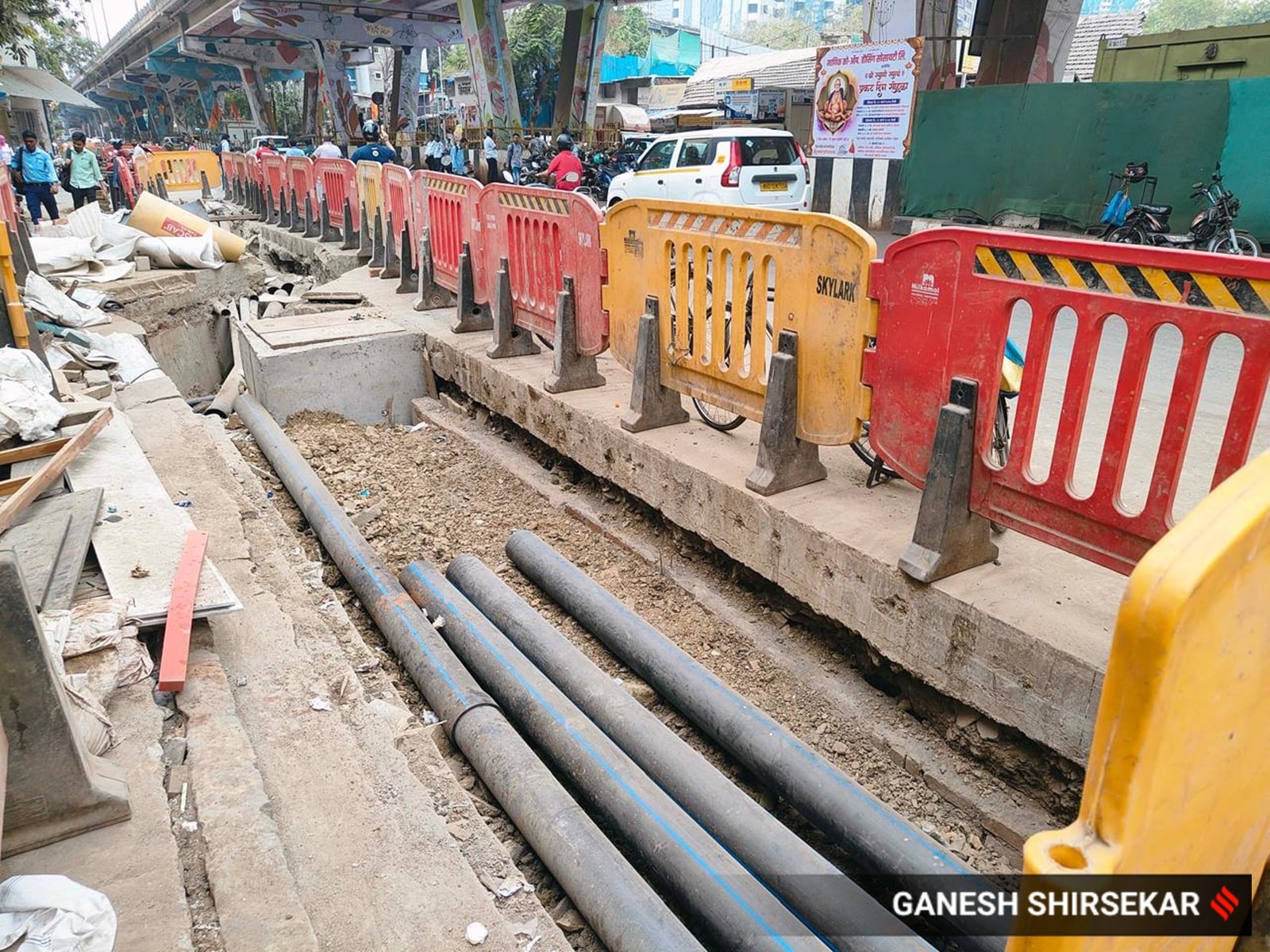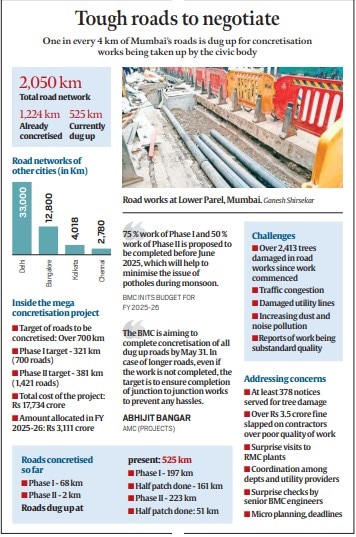
The Brihanmumbai Municipal Corporation (BMC) is working on an ambitious project to concretise city roads, holding a promise of “pothole free” Mumbai. However, it has left Mumbaikars in a state of repulse with nearly every nook and corner — from interior lanes to main swathes — being dug up.
Data from the civic body shows that at present one in every four kilometres of roads in Mumbai are dug up to pave way for the new roads.
While Mumbai has a road network of 2,050 km — less than that of the national capital as well as other Metro cities in India — over 25 per cent or 525 km is dug up at present by the authorities and the BMC has set an ambitious target of completing all the ongoing works by May 31.
Already beleaguered with a weak road network, the rampant digging up of roads has raised concerns over the civic body’s decision to dig up several roads simultaneously. Despite being the financial capital with the highest vehicular density, Mumbai’s overall road network is the lowest among other Metro cities — Delhi has 33,000 km, which is 16 times more than Mumbai; Bangalore has 12,800 km, which is six times more than that of Mumbai, and Kolkata has 4,018 km — double of what Mumbai has — and Chennai has 2,780 km.
The civic body is also racing against time to achieve its goals along with tackling complaints on substandard work, deteriorating air quality and delayed pace, while contractors are raising concerns over Mumbai’s unmapped utility network and constant footfall at worksites.
The project is unfolding at a time when the city is witnessing massive infrastructure changes and the worst hit are the ones one whose life it promised to improve — its residents. Negotiating through a maze of rubble, citizens have been left grappling with the rising dust and noise pollution along with traffic congestion, damaged utility lines, tree-felling and clogged streets.
With only two months left for the onset of monsoon, and considering civil works can’t be taken up for four months during rains, the BMC has set the target of concretising over all the roads dug up at present by May 31, while the entire project, which entails concretising of over 700 kilometres, is slated to be completed by December 2026.
Story continues below this ad
How the project shaped up
In June 2022, when former Chief Minister Eknath Shinde, who had just taken charge, announced plans to make Mumbai’s roads “pothole-free” within two years by concretising the existing asphalt roads. Following the announcement, the civic body issued tenders and awarded contracts for the work orders in two phases, seeking to concretise nearly 700 kilometres of roads across the western, eastern suburbs as well as the island city at a total cost of Rs 17,733 crore.
Of the total network of over 2,050 kilometres in Mumbai, 1,224 km are already concretised. The tenders for the first phase were awarded in January, 2023, while the tenders for the second phase were awarded in August 2024.
 Road works at Lower Parel in Mumbai. (Express Photo by Ganesh Shirsekar)
Road works at Lower Parel in Mumbai. (Express Photo by Ganesh Shirsekar)
Of the two phases, the civic body has set a target of concretising 321 kilometres, amounting to 700 roads, in the first phase while the second phase seeks to concretise over 381 kilometres of roads equivalent to 1,421 roads.
So far, the civic body has achieved 21 per cent of its target in the first phase, having completed works on 68 kilometres. The second phase — the work for which took off in October 2024, has been slower with only 20 roads, amounting to 2 km, concretised so far.
Story continues below this ad
Data accessed by The Indian Express shows that nearly 525 kilometres of the total roads are currently dug up amid unfolding work.
Of the total dug up stretch, as a part of the first phase, the BMC is currently undertaking concretisation works on 197 kilometres of road length, which amounts to 310 roads. Besides this, the civic body is also conducting concretisation on a running stretch of 161 kilometres. According to senior officials, these kilometres comprise lanes where work on half patch is executed while half (80.5 km) is yet to be concreted.
Under the umbrella of the phase II works, meanwhile, nearly 774 roads are dug up with work underway on 223 km. In around 51 km, work is partially complete — leaving roughly 25 km of roads yet to be concretised.
The civic body has now issued an order banning new excavations, urging the public to report any new cases of excavation with their local ward office. However, with nearly 525 kilometres of swathes dug up and awaiting concretisation, nearly one in every four kilometres of the city is already excavated in the city.
Story continues below this ad
Ahead of May 31, officials stated that the BMC is expected to complete concretisation of 203 km in phase 1 and nearly 121 km in the second phase.
Speaking to The Indian Express, Abhijit Bangar, additional municipal commissioner (Projects) said, “Primarily, our objective is to complete works on all the ongoing roads by May 31. We are aiming to complete all the roads that are currently dug up end-to-end.
However, in some cases, where the road length is too long, our goal is to at least complete work from junction to junction, in a bid to avoid any inconvenience.”
In a review meeting on March 25, BMC commissioner and state-appointed administrator Bhushan Gagrani directed officials to ensure micro-planning and specific deadline for completion of targeted roads.
Story continues below this ad
On April 4, the civic chief and top officials from the BMC also chaired a meeting with the contractors, where the target of completing all works before May 31 was reiterated. During the meeting, the BMC said that if any road is found in an incomplete condition, strict action will be taken against the contractor.
Mounting problems
The concreting of roads involves disinterring of the existing road surface in a bid to fill them up with precast concrete layer. This process, however, has come at an expense — toppling of trees, destroying utility supply lines and in some grave situations, human lives.
Data from the civic body shows that as many as 2,413 trees have been damaged in Mumbai since the road concretising works commenced. Of these, at least 26 trees collapsed during the digging works.
So far, at least 378 notices have been served by the BMC’s tree and garden department to the civic roads department, and other utility agencies for hampering roots of trees. More recently, the civic body on March 25 slapped a contractor with a penalty Rs 50,000 after inspection revealed that root zones of as many as 50-60 trees in Prabhadevi — most of which were nearly 35- 40 years old — were weakened due to unscientific digging work.
According to an official from the civic tree and garden cell, the tree department was not consulted before initiating concretisation work. “The contractors are digging the edge of the roots, causing immense damage by making their base weak. The National Green Tribunal (NGT) guidelines mandate that no digging should be done within the one-metre radius of a tree. So technically the way these officers are digging these roads is a violation of rules in general,” the official added.
Story continues below this ad
Dilip Shenai, an ecology and biodiversity expert told The Indian Express that the BMC’s choice of planting exotic trees on the roads of Mumbai are among a reason to be blamed. While trees such as Gulmohar grow fast, they don’t have a proper rooting system, making them susceptible to being uprooted easily, he said.
“There’s contractor apathy as well. They don’t care about trees as they are more concerned about finishing the project within the given deadline. To avert such situations, one needs to have experts on board,” Shenai told Express.
Several fire incidents were also reported after gas pipelines were damaged during road digging. On March 9, one person lost his life, while two other persons were injured after a gas pipeline was damaged in Andheri. The road was being dug by a JCB when the PNG pipeline passing beneath damaged, resulting in vehicles on the road above catching fire.
Following the incident, civic officials issued a statement saying that while concreting work on that particular road was underway, the damage to the pipeline was not caused by the contractor who had taken up concretising work.
Story continues below this ad
On February 27, a blaze erupted in Mahim West after a PNG pipeline was damaged. While no injuries were reported in the incident, a JCB parked at the site caught fire.
When The Indian Express reached out to the Mahanagar Gas Limited (MGL), seeking to know the methods implemented by the agency to tackle the issue of frequent pipeline burst incidents, the agency did not respond.
Citizens’ woes
Among all the woes that concretisation work brings, residents say the major lapse has happened on civic amenities. On April 2, a gas leak occured in Santacruz West during the course of road works, spreading the smell spread far and wide and leaving residents panic-striken. Over 250 flats of the nearby buildings received no gas supply throughout the day.
Recalling the works in their narrow lane near Diamond gardens, Rajkumar Sharma, a resident of Chembur, said that even as traffic was manageable, utility lines took a major hit.
Story continues below this ad
“During the work in our lane, which went on for months, the streetlights were removed and had to be replaced later. On one occasion, the electricity cable was destroyed during the work, leaving us without electricity for over a day. The trenches they dig up were filled with water and that further sparked concerns of mosquito breeding in our area,” said Rajkumar Sharma.
Madhu Poplai of Pali Hill Residents Association (PHRA) said lack of coordination is leading to the work unfolding in a haphazard fashion.
“The area is facing many problems and sewage has been worst affected with the concrete blocks entering sewage lines, leaving them choked. Even the quality of the material being used for works has been substandard with the top coat coming off in many places,” said Poplai.
The civic body has issued several directives to execute works in coordination with the BMC’s hydraulic engineers, storm water drainage and sewage departments as well as other authorities and agencies involved.
 Tough roads to negotiate
Tough roads to negotiate
In the absence of elected representatives amid no civic polls, Poplai said that proper monitoring has also been absent.
Residents of several pockets, including Pali Hill, have opposed concretisation, appealing to the civic body to leave their lanes untouched. Their reason: the lanes are already in good condition and require no intervention. Taking cognisance of the complaints, BMC administrator Gagrani — during the unveiling of the civic budget of this fiscal — also said that the civic body would defer its decision to concretise a road in case of opposition from locals.
Civic challenges
The concretisation work has thrown up several challenges for the BMC itself as well as stakeholders, including contractors and utility providers. According to the civic top brass, finding solutions to prevent repeated digging of concretised roads has emerged as a key challenge for the BMC. Meanwhile, ensuring standards of quality works has also posed a hurdle. In the past months, reports of cracks surfacing on freshly concretised roads left the civic body red-faced, forcing them to issue penalties to the contractors and ramp up inspections.
Abhijit Bangar, AMC (Projects), told The Indian Express that a sum of over Rs 3.5 crore has been imposed on contractors, wherever bad quality of concretisation works has come to light.
With reports of substandard works coming to light, the BMC has also taken to surprise visits to RMC plants. On April 1, AMC (Projects) inspected the RMC plant at Turbhe in a surprise visit to review concrete mix, water temperature and computerised control system among other works. On March 22, during an inspection visit at an ongoing work site at Mankhurd in the eastern suburbs, Bangar found out that the concrete that was used for the road works were not up to the standards.
“Comprising the quality of road works will not be tolerated. We have roped in experts from IIT – Bombay as advisors for the project. Wherever we are noticing any kind of discrepancy related to the quality of work, we are taking strict action. We have also mandated the presence of BMC engineers on the spot when work is ongoing,” Bangar said.
Meanwhile, contractors from several agencies who have been roped in for the works also pointed to an array of challenges ranging from the network of utility supplies running beneath the road surface to traffic congestions.
A spokesperson from a contractual firm said that they do not have adequate charts mapping locations of utility lines such as gas, cable and fibre optics, often resulting in damage of lines. “In the past few months, three separate incidents of gas pipeline damages were reported in Mumbai since the workers were unaware that utility lines were passing from there. Once such an incident happens, we need to cease work to repair the damage, fulfil legal obligations and identify the remaining alignment of the pipeline. Factors like these cost us additional time, slowing the pace of work,” added the spokesperson.
A representative from another contract agency pointed out that unlike highway projects where work entails reclaiming of land parcels and then construction, the ongoing project involves repairs of roads which are operational, slowing down the pace of works. “Since traffic in Mumbai is round the clock, we face challenges in digging roads in entirety. As we are compelled to take up work in patches, it is taking more time than usual. If on a highway project we can achieve 2-3 kilometres of work in a day, in Mumbai, achieving 1 km of work takes us 2-3 days,” the spokesperson said.
Contractors also said that in Mumbai, work cannot be taken up for four months during the monsoon, that leads to an added pressure on finishing the work at a faster pace.
Even though work orders for the first phase of work were issued in January last year, the BMC is yet to achieve 50 per cent of its target so far. Speaking on the slow pace of work, the civic authorities maintained that since Mumbai records heavy rainfall during monsoon, all civil and infrastructure related works are usually stalled between June and October.
“During the rains, the soil particles become loose and you can’t roll on them and the cement used for making the concrete also loses its strength, for which we have to stop the work during the monsoon,” Bangar said.
“Although work orders were issued in January 2023, the actual work could only begin by October. The process of acquiring traffic NOCs for diverting vehicle movement on the roads took a lot of time. However, the pace picked up from October last year and we have taken a steadfast approach where civil works are taken up at a mammoth scale. The reason why so many roads are dug up at a time is to ensure that most of them are prepared as early as possible so that the roads remain free of potholes during the monsoon,” Bangar said.

